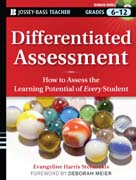
Differentiated assessment: how to assess the learning potential of every student (grades 6-12)
Stefanakis, Evangeline Harri
Meier, Deborah
INDICE: About This Book. About the Author. Acknowledgments. Foreword (Deborah Meier). Introduction. PART I: THE CONTEXT OF LEARNING FOR TODAY AND TOMORROW. 1 Education for the 21st Century. Addressing the Landscape of Assessment Policies and Practice. To Sum Up. 2 Differentiated Instruction Starts with Differentiated Assessments. A Window into Learners Abilities: Adolescents with Learning Challenges. The Demographic Landscape of Assessment Policies and Practice. A Differentiated Assessment System: A Sociocultural Approach. A Comprehensive Assessment System in a High School in the Bronx. To Sum Up. Notes. PART II CASE STUDIES OF DIFFERENTIATED ASSESSMENT. 3 Differentiated Assessment In Middle Schools. Case Studies in Developing Differentiated Assessment. Grant as Catalyst: A Community Designs a System of Differentiated Assessment. Leaders' Lessons: Looking at Students Work Makes Learning Visible. Building a CollaborativeCulture: Key Practices Structure Assessment Conversations. Differentiated Assessment Guides Instruction: Portfolio Rubrics as Common Criteria. Institutionalize Portfolios for Grading and Conferences: Celebrating Student Work. Leaders' Stories: Identifying the Assets of Diverse Groups of Language Learners. Teachers in Middle School Create Classroom Assessment Systems: Setting Standards. Teacher's Classroom Assessment Is Based on 'Sitting Beside' the Language Learner. How Portfolios Help Teachers Become Researchers of Individuals. Profiles and Portfolios: The Window into the Learner's Mind and Potential. Reaching Every Language Learner Personally: Creating a Profile. Good Seeds Grow in Good Cultures: Teachers Create a Portfolio Culture for Learning. To Sum Up. Notes. 4 Differentiated Assessment in High Schools. Why Differentiate the Assessment? A Story of High Schools' Challenges. Differentiating Learners: Knowing the Adults and Children as a Community. Differentiated Assessment: Developing a Classroom Assessment System. Digital Portfolios Introduced as Personal Stories: Windows into the Learner's Mind. Guidelines for Classroom Assessment: Creating/Maintaining Portfolios. To Sum Up. 5 Classroom Assessment with Digital Portfolios.Differentiated Assessment: Seeing the Learner's Abilities. Making Learning Visible with Portfolios. Portfolio Assessment at New Day Academy. New Faculty Getting Started with Digital Portfolios. The Class and the Challenges. Students and Teacher at Work. To Sum Up. Note. PART III SEEING STUDENTS ASSETS: DIFFERENTIATED ASSESSMENT GUIDES INSTRUCTION. 6 Differentiated Assessment, Instruction, and Accommodation. Knowing Your Learner: Understand Cultural and LinguisticAssets. Knowing Your Learners: Building a Comprehensive Assessment System. Using the Student's Assets: Sociocultural Framework to Differentiate Assessment.Classroom Performance Assessments. Differentiated Instruction: Knowing Your Learners and Fi
- ISBN: 978-0-470-23081-7
- Editorial: John Wiley & Sons
- Encuadernacion: Rústica
- Páginas: 192
- Fecha Publicación: 28/12/2010
- Nº Volúmenes: 1
- Idioma: Inglés
